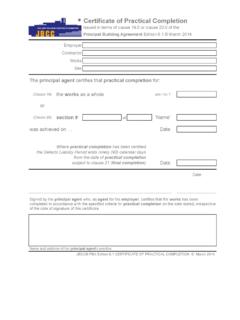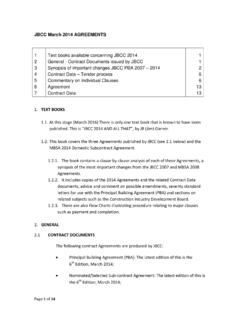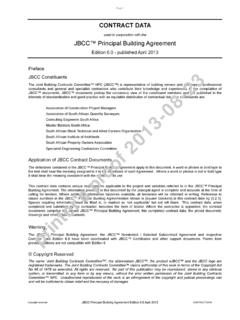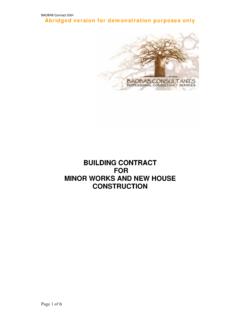Transcription of The impact of choice on construction contract on …
1 1 CLIENT STRATEGIC OBJECTIVES: THE impact OF choice OF construction contract ON project DELIVERYPETER RICHARDS1, PAUL BOWEN1, DAVID ROOT1 AND AKINTOLA AKINTOYE21 Department of construction Economics and Management, University of Cape Town, Private Bag, Rondebosch 7700, Cape Town, South Africa2 School of the Built and Natural Environment, Glasgow Caledonian University, Cowcaddens Road, Glasgow G4 0BA, UKPublished in construction Law Journal No. 7 (2005) 21, Sweet & Maxwell Ltd. and Contributors, London, AbstractMeeting the strategic objectives of construction clients is paramount in construction procurement for the project to be regarded as successful by the client. The contention of this paper is that the choice of contractual arrangement can act as a barrier to achieving these objectives. This paper explores how contractual arrangement can be a delimitation to the client s construction strategic objectives through an analysis of the South Africa JBCC Principal Building Agreement.
2 In addition to the client s strategic objectives, there are currently in South Africa, added strategic development objectives and imperatives that construction procurement should achieve including the creation of sustainable employment, skills development, affirmative action, the active promotion of small and micro- enterprises, and the development of public sector capacity to manage the delivery process. Government policy requires that the construction industry respond to these issues. Such imperatives can only reinforce the need for a choice of an appropriate contractual arrangement. This paper is based on research that comprised a desktop analysis of the JBCC together with the analysis of a single case study to explore how the JBCC Principal Building Agreement addresses the client s strategic objectives in theory and in practice. As a standard form document, it is concluded that the Agreement neither makes provision to deal with the client s strategic objectives nor are they met by its philosophy, structure, or parameters.
3 The research concludes that construction clients who use the agreement or its equivalent for the benefit of its convenience and familiarity should consider its adequacy to manage strategic objectives within the wider sense of the investment and business case of the construction : procurement, contractual arrangement, strategic objectives, business case, construction client, performance measurement, South construction works are procured for strategic reasons by clients that can be broadly defined in terms the client s ultimate use of the facility on completion. The strategic nature of construction raises two pertinent issues, namely, the manner in which construction works are procured and the measures applied to determine project success. In essence all activities related to the process of procurement should be informed, structured and carried out in a manner designed to meet or enhance those objectives strategic to the needs of the construction client.
4 Typically, this would include all the procurement activities, from the evaluation of environmental conditions affecting delivery through to operational use. Consequently, any measures of project performance ought to be tied to the strategic outcome required by the construction client: in terms of the investment/business case, the product, and desired organizational and stakeholder few construction clients possess either the expertise or capacity to undertake building projects on their own, they typically engage external service providers ( architects, engineers, management consultants, constructors and building suppliers) to deliver the building assets that they need. For most clients the activity of building is a complementary or residual activity and hence it is no economic case for them to retain these skills in order to carry on their primary business activities.
5 To engage the service providers, construction clients require contracts - not only to ensure full and adequate performance by the service providers on whom they depend, but also to provide a degree of certainty that the strategic objectives of the transaction are met in a controlled way. The contract thus assumes a pivotal role as a means towards these ends. It is imperative, therefore, that the contract s philosophy, structure and parameters are consistent with the procurement approach adopted to deliver the necessary control over supply chain resources, the manner in which the project will be managed and controlled, and with the choice of criteria selected to measure project success at contracts have evolved into standard contract forms, not only because of their advantages of familiarity and the prohibitive cost of customisation but also to provide certainty on the nature of the transaction between parties on a project specific basis (Masterman, 1997); in effect, to minimise transaction costs.
6 Fellows (1989) has been very critical of this development arguing that the practice is outmoded and that its practice has contributed significantly to many of the construction industry s recent and current difficulties highlighted subsequently by Latham (1993, 1994).The development of these contract forms reflect the building industry s perspective. Terms and conditions are the product of an exclusive dialogue between building trade organizations and the built environment professions. The result is a compromise of beliefs between these parties to form a fair and equitable balance of risk and power in the contract terms. The business needs of the construction client, therefore, are very much a secondary consideration (Cox and Thompson, 1998). Whilst the client may accept this arrangement in order to gain the benefits of the reduced transaction costs within the construction project , the downside of this is that any resulting agreement between the contracting parties is the product of a free commercial negotiation only in a very narrow sense (Root, 2001) and the client is limited in his ability to exercise any direct or meaningful control over the way the process is organised.
7 However, these established contracting practices have come under sustained pressure as clients have started to exert pressure on the industry to better serve their needs (Egan, 1998) and have begun to look to their own sectors for innovative procurement practices (Root et al., 1999). Economic impacts on construction contract practicesEconomic imperatives have put construction contract practice approach under increasing pressure following much criticism of the construction industry s procurement practice in the early 1970 s (Masterman, 1997). The high level of inflation that preceded the 1973-1980 recession permanently affected the financial constraints under which the construction industry was required to achieve strategic outcomes. In the period that has followed, further changes have impacted on the traditional pattern of construction demand and supply including the decline of the skilled construction workforce, the withdrawal of 4the public sector from its dominant role as the sector s principle client, and the steady increase in innovative financing strategies used for scheme development.
8 Client s affected by these changes, and the constraints imposed by a separate and coordinated ( traditional) system of construction procurement to respond to them, have turned to alternative contracting methods like management contracting , design and build , and construction management , as well as innovative financing methods like Build, Operate and Transfer (Masterman, 1997). They have done so in an endeavour to gain better control over delivery processes and contingent business circumstances that affect strategic outcomes South African construction contracts practiceDespite the changes resulting in the use of many other contractual arrangements to solve some of the problems imposed upon the construction industry, the JBCC Principal Building Agreement (1998) in South Africa is widely used for the procurement of a diverse range of construction projects. It is used by both occasional (inexpert) and expert (repeat build) clients.
9 Its wide acceptance has readily made the document an industry standard for construction procurement in South contract , however, exhibits obvious limitations. It is premised on a single procurement system: the traditional or separated and coordinated system of construction procurement - and all the assumptions of procurement strategy that its format necessarily implies. The division of roles and responsibilities between the construction client and the contractor contemplates a strict separation of process between design and specification, and the activities related to construction . The construction client is responsible for the former and the building contractor is accountable for the latter. The conditions of risk within the document relate only to those risks arising from the division of roles and responsibilities between the contracting parties and works execution for delivery of the construction product.
10 Transactional behaviour is regulated by a provision for penalties for delayed/non-performance, and a procedure for the resolution of conflict based on third-party determination. The contract is thus premised on an arms-length adversarial supply 5relationship whereby one party (aided by his professional advisors) seeks to define the building that is to be delivered) with the other party required to deliver the building so described (in the drawings, specifications and bills of quantities). The mechanism for reimbursement requires interim payments to be made to the contractor at regular intervals against actual work progress, irrespective of whether the criteria for overall project success is being fully met or not. The employer s principal agent, who enjoys wide powers of administration under the Agreement, bears no responsibility for process or project outcome under its terms.







